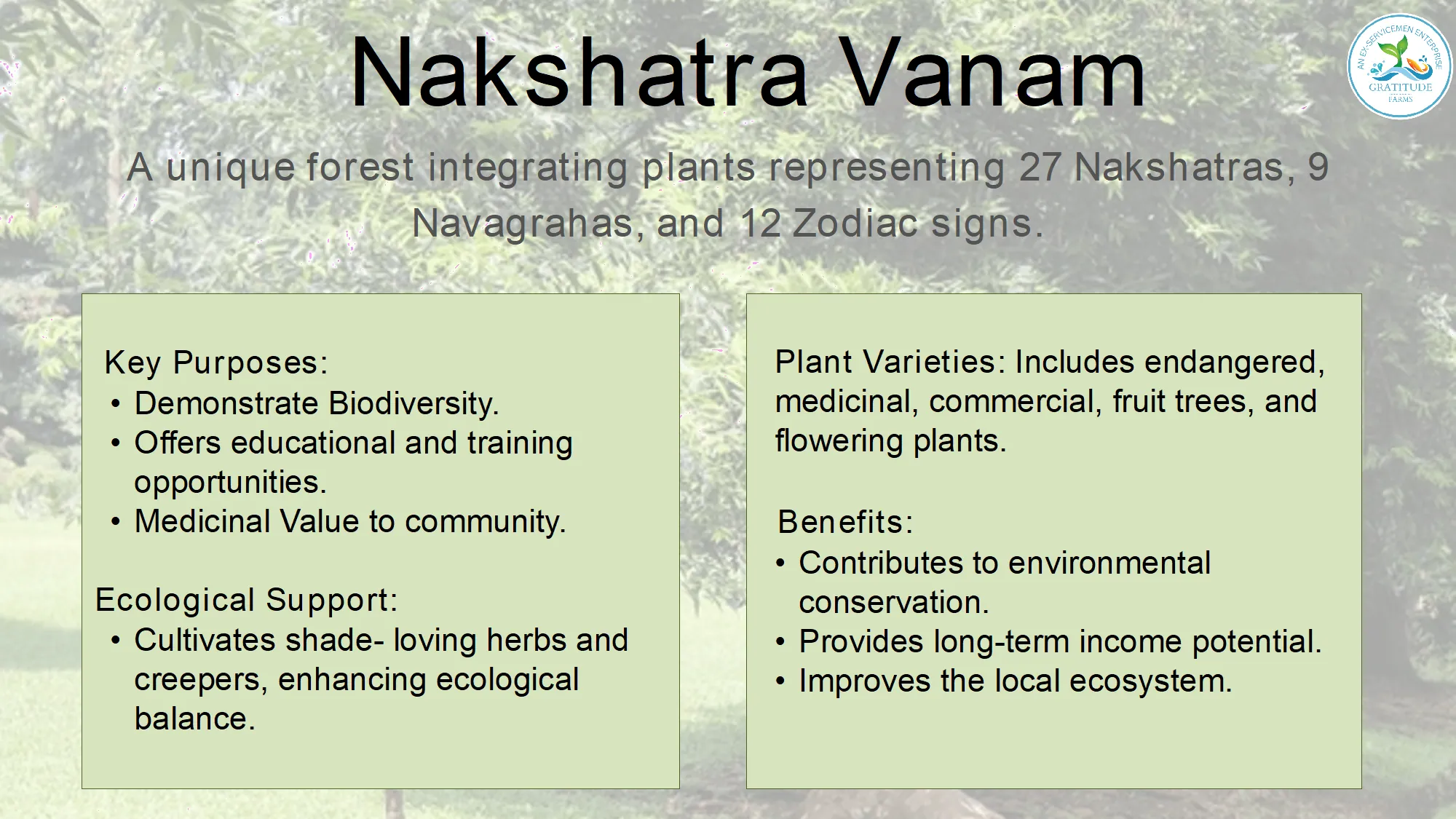About Nakshatra Vanam
Discovering Nakshatra Vanam: A Personal Connection to the Cosmos and Nature
Have you ever felt a profound connection to nature, almost as if certain plants or trees are calling out to you? Or perhaps you’re drawn to astrology and the idea that the stars influence our lives? Well, Nakshatra Vanam might just be the perfect blend of both!
Imagine a garden where each plant is linked to a specific constellation, a cosmic map laid out in living greenery. That’s essentially what Nakshatra Vanam is: a sacred grove where plants are carefully chosen and arranged according to Vedic astrology, an ancient Indian system that believes the position of celestial bodies at the time of your birth influences your life.
Think of it as your personal star-powered garden.
A Journey Through Ancient Roots
The concept of Nakshatra Vanam isn’t new; it’s deeply rooted in Vedic tradition. “Nakshatra” literally translates to “star”, referring to the 27 segments the night sky is divided into according to Vedic astrology. Each Nakshatra is associated with a specific tree or plant.
Tradition holds that nurturing the tree linked to your birth Nakshatra (your “birth star”) brings well-being, spiritual progress, and health. Now, you may be thinking: “Is this just superstition?” Well, here’s the interesting part: The trees selected for Nakshatra Vanam are not just random choices; they’re often selected for their ecological importance, medicinal value, or contribution to biodiversity.
Nakshatra Vanam (Astro Star Forest / Sacred Forest / Sacred Grove) – 35 plants and trees represent:
- Astrological Birth Stars (27 species)
- Navagraha (9 Planets) and
- 12 Raashis (Zodiac)
Origins in Vedic Tradition and Spiritual-Ecological Concept
Nakshatra Vanam, literally meaning “Star Grove,” is a living tradition deeply embedded in ancient Indian cosmology and spiritual ecology. Stemming from Vedic astrology, the Nakshatra system divides the night sky into 27 segments, each known as a Nakshatra or lunar mansion. Tradition holds that each Nakshatra is ruled by a specific tree or plant species—sometimes called one’s “birth tree.” Planting and nurturing the tree associated with one’s Nakshatra is said to bring well-being, spiritual progress, and health. This custom is far from superstition: each of the 27 trees selected for Nakshatra Vanam are also notable for their ecological impact, medicinal value, or importance to biodiversity.
Each Nakshatra tree holds unique spiritual and medicinal properties, influencing health, personality, and prosperity.
For example, Peepal (Ficus religiosa) for Pushya Nakshatra is renowned in Ayurveda for supporting longevity, while sacred rituals associate specific trees with healing and energy balance. Collectively, the grove is deemed auspicious, believed to cleanse negative influences.
Modern Interpretations: Where Science Meets Spirituality
What is really cool is how Nakshatra Vanam is being re-interpreted for the modern world. They’re not just about ancient rituals anymore; they’re about blending traditional wisdom with scientific practices.
Modern implementations of Nakshatra Vanams use a combination of traditional wisdom and scientific practice. On the ground, these groves are usually arranged in a circle or mandala, each segment corresponding to one Nakshatra tree. In some places, for instance, temple trusts and NGOs have revived Nakshatra-themed parks, reporting a measurable increase in public engagement and tree survival rates.
The spiritual aspect is now complemented by modern ecological science: planting the “birth tree” is not just a ritual but a way to foster biodiversity, carbon capture, and climate resilience. Ecologists note that Nakshatra Vanams, when implemented systematically, act as micro-reserves for medicinal and keystone native species that are otherwise threatened by developmental pressures.
Psychological studies have shown that being in nature reduces anxiety and improves mood. Thematic planting, like Nakshatra Vanam, can create spaces that encourage people to connect with nature on a deeper level.

How to Create Your Own Nakshatra-Inspired Oasis
You don’t need to be an expert astrologer or botanist to incorporate the spirit of Nakshatra Vanam into your life. Here are a few ideas:
Discover Your Birth Star and Its Plant: Find out your birth Nakshatra (there are plenty of online calculators). Then, learn about the associated plant. Consider planting it in your garden, or even just keeping a small version in a pot / grow-bag.
Visit a Nakshatra Vanam: Many temples, schools, and eco-farms in India (especially in Telangana and Tamil Nadu) have created Nakshatra Vanam. Visiting one can be a great way to learn more and experience the concept firsthand.
Create a Themed Garden: Even if you do not follow the exact astrological alignments, you can create a garden inspired by Nakshatra Vanam. Choose plants with medicinal properties, or focus on native species that attract pollinators.
Connect to the Cosmos: Spend time in your garden, observing the night sky. Learn about the constellations and the stories behind them. It is a beautiful way to feel connected to something larger than yourself.
Integrate Natural Farming Principles: Adopt sustainable practices like using natural fertilizers, composting, and rainwater harvesting in your garden.
Glimpse into the Nakshatra Vanam Trees and Their Significance
Each plant holds a unique significance, and learning about them can deepen your appreciation for the interconnectedness of nature and the cosmos.

Examples of Nakshatra Vanam Implementations around the Country
It is interesting to note that a number of Educational and Spiritual Organisations as well Community Initiatives are implementing Nakshatra Vanams. Here are a few examples:
- IIM Indore: The Indian Institute of Management Indore has established a Nakshatra Vanam within its campus as part of its commitment to environmental sustainability and holistic well-being for its students and faculty.
- Sri Sri Ravishankar Ashram (Art of Living International Center), Bangalore: This sprawling ashram features a Nakshatra Vanam designed to promote spiritual connection and environmental harmony. The garden is often used for educational workshops and meditative practices.
- Vivekananda Kendra, Kanyakumari: This spiritual and service organization has incorporated Nakshatra Vanams in several of its centers to promote environmental awareness and traditional knowledge.
- ISKCON (International Society for Krishna Consciousness) Temples: Several ISKCON temples across India have established Nakshatra Vanams as part of their devotional gardens and environmental initiatives.
- Yashwantrao Chavan Institute of Science, Satara (Maharashtra): Implemented as a part of integrating cultural heritage with scientific studies and promoting awareness about biodiversity and traditional knowledge among students.
- Dr. Panjabrao Deshmukh Krishi Vidyapeeth (Agricultural University), Akola (Maharashtra): Primarily for research and education, it provides insights into the ecological aspects of the plants associated with Nakshatras.
- Municipal Gardens/Parks: Several municipal corporations in cities like Pune and Hyderabad have established Nakshatra Vanams in public parks to promote environmental awareness among citizens.
- Educational Institutions (Schools and Colleges in Tamil Nadu and Telangana): Many schools and colleges in South India have incorporated Nakshatra Vanams as part of their environmental education programs.
- Temples in Kerala: Various temples in Kerala maintain Nakshatra Vanams as a part of their sacred groves, preserving traditional ecological knowledge and cultural practices.
Why Nakshatra Vanam Matters
In a world that often feels disconnected from nature, Nakshatra Vanam offers a way to reconnect. It’s a reminder that we are part of a larger ecosystem, influenced by the stars and nourished by the earth. By creating these sacred groves, we’re not just planting trees; we’re planting seeds of hope, healing, and harmony.
Conclusion: Blending our Ancient Knowledge with Modern Methods for Planetary Health
Nakshatra Vanam offers a beautiful pathway to appreciate nature, culture, and the cosmos. Whether you choose to plant a single tree or create an entire grove, embrace the spirit of Nakshatra Vanam and cultivate a deeper connection to yourself, the earth, and the stars.
We at Gratitude Farms, are implementing Nakshatra Vanam as part of our design of our Farmlands, gracefully combining principles of Vriksh Ayurveda (with a deep emphasis on harmony with nature and sustainable practices) with modern environmental metrics. As cities worldwide seek effective, culturally resonant models for ecological restoration, Nakshatra Vanam promises healing—of planet, mind, and spirit.
Our goal is to integrate India’s rich cultural heritage with modern agricultural practices. Nakshatra Vanam helps provide a deep connection between individuals and communities with nature – a very critical need in today’s age and time.


